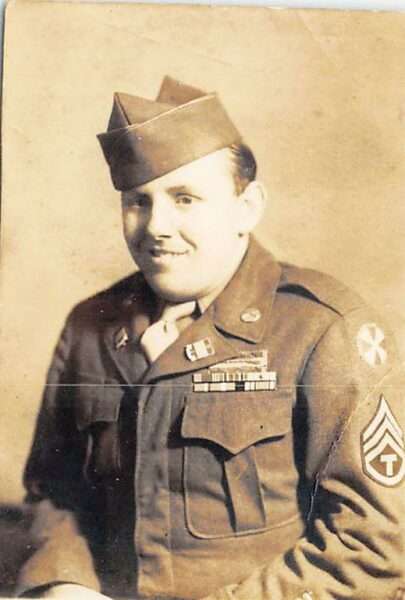In the library at Canterfield of Oak Ridge, Dean Ford pulled out a photo taken by an Army photographer friend.
While the image is a small, black-and-white copy of the even smaller original photo in a sepia tone, it shows a moment of great historical weight. A group of straight-faced Japanese prisoners sit, transported by U.S. Army soldiers. At the photo’s left, according to Ford, sits Hideki Tojo, Japanese minister of war and later the prime minister during World War II. The U.S. later executed him for his war crimes and Ford, speaking to The Oak Ridger, compared him to Hitler.
“These were the guys who wouldn’t take the first bomb as enough. (We) had to put in another one,” Ford said regarding the prisoners in the photo. He said some of the other prisoners in the photo were naval officers and others worked for the Mitsubishi company doing manufacturing work during the war.

Japanese prisoners of war are shown in htis photo kept by Dean Ford, who lives at Canterfield of Oak Ridge. At far left, designated by the words and arrow is Hideki Tojo, the Japanese minister of war and later the prime minister during World War II. Stone doesn’t remember the name of the photographer he knew who captured this photo during WWII. (The Oak Ridger/TNS)
“Their biggest war crimes were in China. They killed thousands of people,” he said of the Japanese military, later saying they killed “thousands of Chinese children.” He also spoke about Japanese soldiers cannibalizing enemy soldiers.
Ford said he kept track of this photo, in spite of moving over the years.
Ford served in the U.S. Army during the war while his brother served in the Navy.
“Of course there ain’t no good wars, but there are good fighters,” Ford said of men like his brother who served at Guadalcanal, Tokyo and the Coral Sea.
In his interview, Ford spoke about his own service during the war, including the building of Oak Ridge during the Manhattan Project, combat in the Pacific and tasks connected to the early days of post-war U.S.-occupied Japan.
“We got people right now that don’t know anything about it,” Ford said regarding World War II “We saved the world … They called us the greatest generation.”
Ford was born in Scott County, Tenn., on June 9, 1926.

A young Dean Ford in the U.S. Army. (The Oak Ridger/TNS)
In 1942 at age 16 he worked as a water boy helping the people constructing housing in what would become present-day Oak Ridge.
The Oak Ridge area was under construction for a secret purposes: to enrich uranium for bombs, but Ford, who rode in to work on a bus, said he did not know it at the time.
“We knew it was top secret, but if anyone knew too much, they’d ship them out,” he said.
In 1944 at age 18, Ford joined the Army. He served in the Army infantry and became a tech sergeant. During the war, he served in the Philippines and Okinawa, Japan.
He described being in combat in the Pacific, carrying an M1 rifle and a “pocket full of grenades” and going “ashore … doing battle” in Okinawa in 1945.
He explained that this fighting was different from later conflicts involving the United States.
“Wars have changed,” he said, explaining that in World War II, there was a clear “front line,” unlike in later conflicts like Korea, Vietnam and Afghanistan.
“There’s a million heroes we never hear about,” he said, regarding people who have served in those later wars.
In 1945, the atomic bombs would be dropped on Hiroshima and Nagasaki, Japan. Ford said he was in the Philippines when the first bomb went off.
“To have been part of such a major victory anywhere you worked you were glad,” he said regarding his thoughts on his own brief involvement in Oak Ridge after hearing about the war’s end.
After the war, he continued to serve on occupation duty.
“It was mostly being there,” he said of his actions at that time. However, he described a few particular missions, including driving Japanese weapons to a ship to take them out of the country. He later worked as a mess sergeant in an automotive school, cooking food for soldiers who were stationed at the barracks there.
He described various things he and others did for fun in post-war Japan, including going out for beer and to the movies and seeing kabuki theater productions. “Japanese girls weren’t too bad to look at,” Ford added.
Ford left the Army in 1947, after he’d gotten “the points” that allowed him to leave. He moved to Oliver Springs after the war, but continued to work in Oak Ridge in construction.
After the war, he married “a girl from Oliver Springs,” who had stayed in Oak Ridge. His wife, Pauline Jones, now deceased, worked at Y-12 during the war. Ford describes her as a “well-known calutron girl who made the ‘product'”— the wartime term for enriched uranium. They had three children – Linda, Nancy and Earnie.
Ford himself worked at Y-12 during some of his post-war years at the machine shop, which he describes as good work that paid well. These days he lives at Canterfield of Oak Ridge, an assisted living facility.
“It’s just an amazing place,” Ford said of Oak Ridge, describing the progress made in computing there and its “cosmopolitan” nature, combining people with doctorate degrees with less educated people.
___
© 2019 Oak Ridger
Distributed by Tribune Content Agency, LLC.



